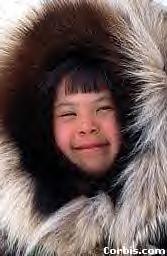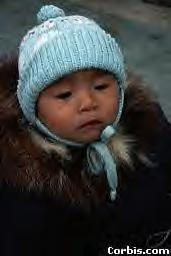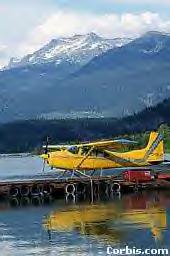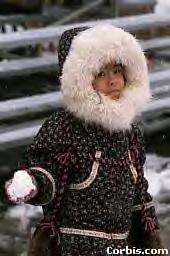|
 NUSHAGAK PENINSULA,
Alaska - The small plane's engine drones as we circle a depression in the flat tundra. NUSHAGAK PENINSULA,
Alaska - The small plane's engine drones as we circle a depression in the flat tundra.
"See there," says Karen Roberts, my Yup'ik
Eskimo guide, pointing at the ground. "That's where my grandmother was born."
I have no idea what she means. There's no house there,
nothing but yellow grass as far as I can see on this southwest Alaska peninsula.
The grassy depression is what's left of a traditional
Eskimo house built into the ground and shored up with whalebone and covered with a sod roof, she says. A number
of such houses made up a small Eskimo village south of Dillingham on Bristol Bay.
For the next 15 minutes, Karen fills me in on 300
years of the history of Bristol Bay from the Yup'ik (pronounced "you-pick") perspective - including the
arrival of canneries and boarding schools, the 1918 flu epidemic, the move from villages to towns, the intermarriage
of Yup'ik people to cannery workers.
Karen's high cheekbones, brown eyes and round face
indicate her Yup'ik Eskimo heritage; her fair skin coloring and light brown hair are vestiges of her Nordic grandfather.
In her mid-30s, she lives with her two children in a modern house in Dillingham, a small, rugged fishing town on
the northeast end of Bristol Bay.
She tells me that when her grandmother was a girl,
the sod house she lived in had been occupied for more than 300 years. Fresh water was fetched from the river, the
long winter's darkness was illuminated with a flame of burning seal oil pooled in stone lamps, and dietary staples
were raw fish and the meat of sea mammals.
 She talks of early-day Yup'ik families who traveled and hunted in skin boats (early-day kayaks) and
wore parkas stuffed with grass as insulation against the cold. She talks of early-day Yup'ik families who traveled and hunted in skin boats (early-day kayaks) and
wore parkas stuffed with grass as insulation against the cold.
Karen is my connection, as only a local and a Native
can be, to the history of the Yup'ik and their lives today.
We're flying to a remote wilderness village to meet
her people; to fish with an Eskimo family at their tent camp on the Nushagak River; to watch for beluga whales
with a Yup'ik harpooner; to visit Eskimo doll and basket makers at their homes; and to see the local museum that
houses Native artifacts. Most of all, I'll meet Karen's network of family and friends, mostly Yup'ik people I would
not have known without her.
Karen's tour business out of Dillingham is a small
link in Alaska's large Native-tourism chain that provides jobs and futures for Native peoples and helps keep their
culture alive.
She's a shareholder in both the regional Bristol Bay
Native Corp., based in Anchorage (one of 13 such Native corporations in Alaska), and her local Native corporation,
Choggiung (one of 256 such locals in the state), based in Dillingham.
The regional unit looks at the big picture for a land
mass on the Bering Sea that's about the size of Washington, Oregon, Montana and Idaho combined. It wants to stimulate
the local economy beyond the mainstays of fishing, mining, forestry and manufacturing. Today, that extension is
into tourism - hotels, cruise shops, tours, interpretive centers and museums.
Choggiung has offices in a modern Dillingham office
building filled with local Yup'ik Eskimo art. It owns the only hotel in Dillingham, is invested in a local upscale
fishing lodge, owns the land on both sides of the Nuchigak River - one of the most prolific trophy-fishing rivers
in Alaska - and has contributed money to the local museum that showcases Yup'ik culture.
Such development by and for the Natives also makes
for richer experiences for the visitor.
 Walk on permafrost with an Eskimo and the word "tundra" will take on a new meaning. Watch
a totem carver slice through cedar as if it were butter (then try it yourself) and you'll have new appreciation
for the woodcarving tradition. Walk on permafrost with an Eskimo and the word "tundra" will take on a new meaning. Watch
a totem carver slice through cedar as if it were butter (then try it yourself) and you'll have new appreciation
for the woodcarving tradition.
Alaska Natives whose families have occupied the same
ground for 1,500 to 10,000 years live the history. They can transform common things like a tool shed or a weathered
boat into a fascinating tale of history.
Today, you can walk and talk with the Inupiat, Yup'ik,
and Chup'ik Eskimos who live on the Arctic and Bering Sea, the Athabascan Indians of interior Alaska, the Unungan
people of the Aleutian Islands, the Alutiiqs on the Kodiak archipelago, the Chugach and Eyak in the Gulf of Alaska,
and the Tlingit, Tsimshian and Haida Indians of Southeast Alaska.
There are individual tours, group tours, cultural
interpretive centers, museums and tours of Native artist's studios. With Alaska's size (superimposed over a map
of the United States, Alaska stretches from California to Florida), you won't run out of things to do.
Going by bush plane
On our early-morning flight from Dillingham on a six-seater
bush plane, our Native pilot takes us over the northern coast of Bristol Bay to the Togiak Wilderness Area - about
100 miles - to Igushik beach, an Eskimo summer fishing camp that has been in use for centuries.
 We land on a fine gravel beach that crunches under our feet. We land on a fine gravel beach that crunches under our feet.
As the tide rises, the plane quickly reloads with
Yup'ik Eskimo passengers heading to Dillingham for supplies and takes off. Karen and I stay. We'll be here until
the next low tide (about six hours) when our pilot can land again.
If the weather suddenly turns sour, as it often does,
we may be here longer than a day, a common experience in Alaska's remote villages where there are no roads and
all travel is by bush or float plane.
About 30 weathered little wood cabins are strung along
the beach for nearly a mile, all nestled in knee-high grass and wild iris.The air is fresh and clean; wind blows
across the treeless tundra meadows that stretch to the horizon.
Bright laundry, washed in generator-powered wringer
washing machines, flaps on clotheslines strung between driftwood posts.Fishnets piled on the ground glisten in
the sun. Neatly filleted salmon lay on racks above smoldering driftwood fires.
Swallows twitter and sweep past our faces and glide
into birdhouses nailed under the eaves of nearly every cabin. There's not a soul in sight, just rows of empty aluminum
skiffs on the beach.
Karen knocks on a cabin door and we're welcomed inside.
A Yup'ik mom and her three kids, Karen's cousins, are waking up. Sun pouring through paned windows fights to lighten
the dark wooden walls.
A metal coffee pot sits on a red propane-fired cook
stove and pancakes brown on the grill.
We sit at a wooden kitchen table. The children smile
shyly from a doorway to a room with two sets of bunk beds.
 This family,
along with most of the rest of the Native inhabitants of Manokotak, their village about 30 miles upstream, packs
up and moves here for the summer to catch and prepare the salmon that will help sustain them during the winter. This family,
along with most of the rest of the Native inhabitants of Manokotak, their village about 30 miles upstream, packs
up and moves here for the summer to catch and prepare the salmon that will help sustain them during the winter.
Manokotak itself is a small cluster of houses not
much larger than these summer cabins, plus a church, a grocery store and a school.
While schools insist on English, home chat is in both
English and Yup'ik, a language full of lovely softness that sounds similar to Hawaiian with its many vowels.
We borrow the family's four-wheel-drive ATV for a
spin down the beach. We visit families in their cabins, patting a baby here and there, and check out the two-room
maqi (traditional steam baths) behind the houses. Heated by a cast-iron stove and filled with steam by water poured
on hot rocks, the maqi resembles a steam bath more than a Finnish sauna.
Excavations of 500-year-old sod houses found steam
rooms adjoining the main room of the houses.
I don't want to intrude, so I take no pictures. I
stay at Karen's side and listen. Many of my perceptions of Eskimo lifestyle evaporate. For one thing, it's nearly
70 degrees on this summer day, and none of the ancestors of the Yup'ik people ever lived in an igloo.
By week's end, we've flown into spectacular Wood-Tikchik
State Park, a stair step of 12 pristine lakes connected by short rivers, to see herds of caribou, solitary moose
and bears - and to see where Eskimo families once lived and traveled inland on this waterway.
We've stayed with the Larceny family in their tent
camp on the Nushagak River and eaten caribou they've butchered for breakfast. I've perched alongside Andy Golly,
a Yup'ik harpooner, as we skimmed across Nushagak Bay in his skiff to see white beluga whales and their calves.
We've toured the historic Peter Pan cannery in Dillingham,
learned about the influx to Bristol Bay of foreigners from all over the world in the 1800s, and met two Yup'ik
men repairing nets by hand.
We've spent several hours in Dillingham Samuel K.
Fox Museum to learn about Bristol Bay's early days, the Russian occupation in the 1700s, the influx of canneries
in the 1800s.
 We've learned
that many Yup'ik families have at least one Norwegian, Irish, Filipino, Chinese or Dutch grandfather fisherman
who came here to work, fell in love with a Yup'ik girl and stayed. We've learned
that many Yup'ik families have at least one Norwegian, Irish, Filipino, Chinese or Dutch grandfather fisherman
who came here to work, fell in love with a Yup'ik girl and stayed.
I see the stone lamp that Karen's grandmother used
and now know what it took to kill the seal that provided the lamp's oil, and the way the lamp smoked in the dark.
Karen has been my bridge between the past and the
present of Alaska.
Jan Halliday is a Port Townsend freelance writer.
She is the author of Native Peoples of Alaska:
A Traveler's Guide to Land, Art and Culture (Sasquatch Books, 1998. $17.95).
E-mail: halliday@olympus.net.
The story for this electronic field trip is built around the theme of man's ability and need to carve out a "niche"
for himself in the world around him
Interactive Field Trip to Alaska
http://newmedia.scetv.org/fieldtrip
Play this interactive game to identify Alaskan birds
What
Am I?
http://www.state.ak.us/local/akpages/FISH.GAME/wildlife/geninfo/birds/whatami.htm
|
 NUSHAGAK PENINSULA,
Alaska - The small plane's engine drones as we circle a depression in the flat tundra.
NUSHAGAK PENINSULA,
Alaska - The small plane's engine drones as we circle a depression in the flat tundra.


 This family,
along with most of the rest of the Native inhabitants of Manokotak, their village about 30 miles upstream, packs
up and moves here for the summer to catch and prepare the salmon that will help sustain them during the winter.
This family,
along with most of the rest of the Native inhabitants of Manokotak, their village about 30 miles upstream, packs
up and moves here for the summer to catch and prepare the salmon that will help sustain them during the winter.We've learned
that many Yup'ik families have at least one Norwegian, Irish, Filipino, Chinese or Dutch grandfather fisherman
who came here to work, fell in love with a Yup'ik girl and stayed.
![]()